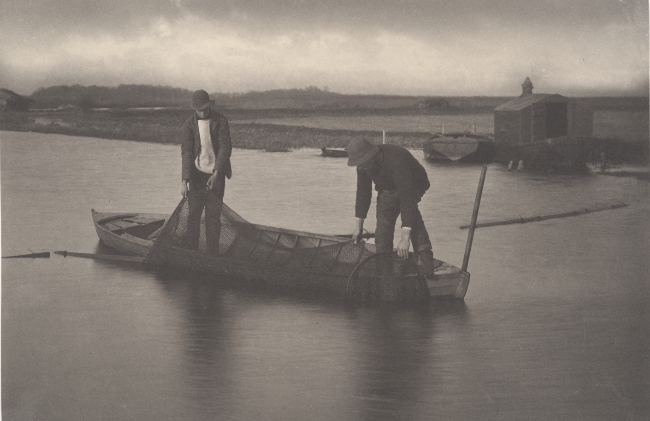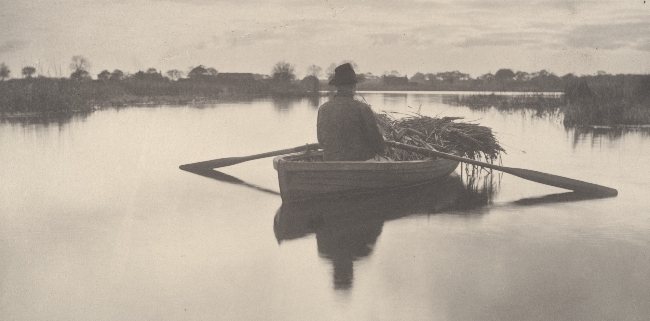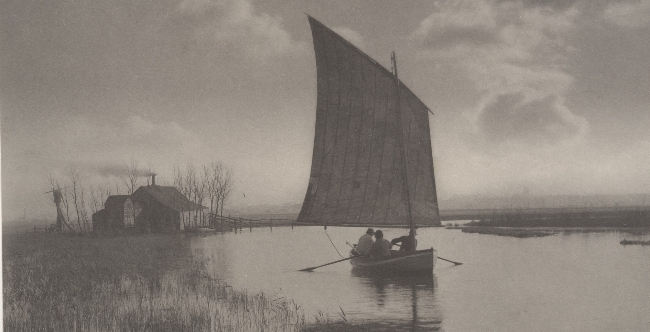Peter Henry Emerson was a child of privilege. He was born in Cuba in 1856; his mother was a member of British society, his father a wealthy American. His cousin was the poet Ralph Waldo Emerson. His youth was divided between Cuba and New England. In 1869, when war broke out between Spain and Cuba, Emerson’s parents sent him to school in England.
Emerson eventually studied medicine and by the age of 29 he’d become a Fellow of the Royal College of Surgeons. Medicine wasn’t his only interest, though. This was the era of gentlemanly amateurism; men of privilege spent as much study and effort on their recreation as they did on professions. Emerson was also a serious amateur meteorologist, a champion billiards player, a detective novelist and an avid birder. It was his interest in ornithology that led him, in 1882, to purchase a camera. He hoped it would be a valuable aid in his study of local birds.
The camera at that time was still widely considered mainly as an unwieldy but useful tool; photography was often depicted as a science closely related to chemistry. Although some artists used photographs as a basis for painting (especially portraitists, who found it more convenient to work from a photograph than from a live model), photography was generally considered too impersonal and mechanical to be regarded as an actual art form. Only a few photographers (such as Oscar G. Rejlander and Henry Peach Robinson) were attempting to use photography to create art. For the most part, they created very formally posed tableaux that imitated the classic styles of painting.
Peter Henry Emerson turned all that on its head.

Emerson’s interest in photography quickly consumed him. He abandoned his medical career, he stopped playing billiards, he no longer attended lectures on meteorology, he stopped writing detective novels; instead he devoted himself to photography. Rather than using his camera to study bird life, he turned his lens on the rural life of the fens and marshes of East Anglia.
He absolutely rejected the stiff, posed literary-style tableaux that dominated the artistic aspect of photography. He described that school of photography as artificial and sentimental. Instead, Emerson advocated a more natural approach to photography, a relaxed style that emphasized organic settings and the spontaneous poses of ordinary people engaged in ordinary behavior.
Within three years of buying his camera Emerson was exhibiting his work, winning prizes, and gaining converts to his controversial new style of photography.
>
A Toad in the Path – An Early Spring in Norfolk 1888
Emerson’s approach caused a massive rift in the photographic community. For the preceding decade, the ‘bible’ of photography was Henry Peach Robinson’s ponderous tome Pictorial Effect in Photography, Being Hints on Composition and Chiaroscuro for Photographers. Emerson rejected nearly everything Robinson advocated. He described Robinson’s book as “the quintessence of literary fallacies and art anachronisms” and argued that photography was more than a mechanical method of recording. Photography, Emerson claimed, should be considered an art form in its own right.
In 1889 Emerson published a book detailing his views and theories, Naturalistic Photography for Students of Art. The effect of the book on the photographic community was, according to one reviewer, “like dropping a bombshell at a tea-party.” In his book Emerson encouraged photographers to “Photograph people as they really are.”

Although he was promoting photography as an art, Emerson’s background in the sciences also influenced his approach. He wrote:
“Nothing in nature has a hard outline, but everything is seen against something else, and its outlines fade gently into something else, often so subtly that you cannot quite distinguish where one ends and the other begins. In this mingled decision and indecision, this lost and found, lies all the charm and mystery of nature.”
To achieve the effect of the human eye, Emerson began to create photographs in which the center of the image was sharp but the periphery was deliberately very slightly blurred. This approach outraged the photographic establishment, who were of the opinion that what made photography unique was the ability of the camera to mechanically recreate reality with absolute clarity. Their goal had always been to be sure that everything in the frame was perfectly sharp. Emerson was decried as a heretic.

The quarrel between the traditionalists and Emerson’s naturalists was made all the more bitter by Emerson’s arrogance and passionate temper. He had a tendency to respond to his critics with sarcasm and vitriolic personal attacks.
While the debate over photography as an art form raged, advances were continuing in the more scientific realms of photography. Because of his background in the hard sciences, Emerson could not–or would not–relinquish his belief in objectivity. As a result, during a debate on photography, he was forced to acknowledge two uncomfortable facts; first, that photography was a process of mechanical reproduction, and second, that the mechanical reproduction of reality was not–and could not be–art.
Emerson found himself boxed in. He’d argued that photography could be an art form in its own right, but then he also acknowledged that it couldn’t be an art form. There was no room for nuance in Emerson’s philosophy. Although he continued to take photographs for a few more years, Emerson eventually published a pamphlet called “The Death of Naturalistic Photography” and withdrew from the photographic community.
The photographic career of Peter Henry Emerson was relatively brief and wildly mercurial, but it was also profoundly influential. He was among the first to champion photography as an art form in its own right. He was among the first to advocate an organic form of photography that stressed ordinary life. He was among the first photographers to insist that the lives of country people was worthy of artistic study. Emerson developed an approach to photography that we still build on to this day.
